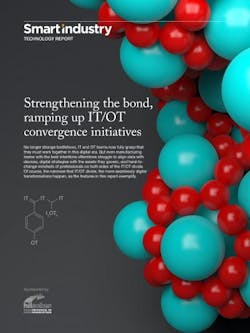Real-time ethernet, TSN & OPC UA building the industrial internet
By Phil Marshall, CEO Hilscher North America, Inc.
Data communications are the foundation of modern automation. The digital age welcomed in first fieldbus and then ethernet, bringing device-to-controller and controller-to-controller connectivity. Deterministic—that is, predictable—performance is essential and real-time requires additions to the ethernet specification.
Hilscher's Phil Marshall
Several ways of achieving that have been developed and “industrial ethernet” has become one of the driving forces behind modern automation systems. There are several versions however, none of which are compatible, and that has led to the same diversification of solutions as with fieldbus.
Users often find themselves captured inside a particular communications universe as a result. This is not intrinsically bad, since all vendors support product ranges (from field devices to PLCs and DCSs) that deliver excellent results. However, two difficulties result: third parties have to support all universes and end users do not have an open field to deal with.
Hilscher realized that the market needed to support all universes equally, so we developed a flexible adapter solution. This was also the motivation to launch our own family of netX chips that enable a product to be configured for any popular protocol via a simple configuration change. Gateways and adapters like the netTAP and cifX PC card families offer single-solution interfaces capable of serving all protocol universes—whether built into a device by the OEM or implemented in the field by the system integrator or end user.
Synchronize data transfers with TSN
Since it’s unlikely that the various communication universes will ever merge into a single protocol solution, perhaps a way of synchronizing data transfers might help. That’s the underlying premise of Time-Sensitive Networking (TSN).
With TSN, critical and non-critical traffic share one network. Higher-layer protocols share the infrastructure, so real-time control can be extended away from the operations area. Sub-systems can be integrated more easily, components can be added without network or equipment alterations, and network faults can be diagnosed and repaired faster. It’s generally accepted that, as greater interoperability becomes a reality, plants will become simpler to design and maintain, and that new automation methodologies could arise.
The full TSN specification is still emerging. Hilscher’s latest netX chips are already compliant with the most recent TSN releases and are ready to adopt the full specification once it is finalized. And that means critical Hilscher infrastructure products such as gateways and network adapters will be able to follow the market as the various industrial ethernet protocols adopt TSN into their own specifications.
Enter OPC UA and MQTT
Two standards that have been around for a couple of decades are becoming important for the industrial internet: OPC UA and MQTT. OPC UA, with its clever information model concept (and now with TSN included—OPC UA TSN), promises network transparency literally from plant floor to cloud. And not just for raw data but also for “information”—i.e. data that carries meaning. MQTT, a “light” messaging protocol, will also be important in this context, though probably linked with middleware products that can add the semantics needed by higher-level systems. Hilscher netX chips support both OPC UA and MQTT.
The industrial internet forms the backbone of IIoT applications. Leveraging standards such as real-time ethernet, TSN and OPC UA will make it a reality.






